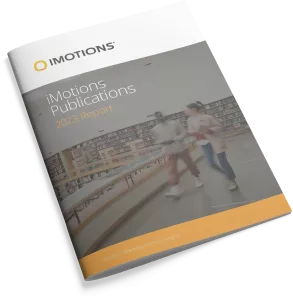-
Emotional Journey for an Emotion Provoking Cycling Exergame
Abstract: In this work we present a novel concept for affective entertainment, which we call Emotional Journey. It provides a dynamic and adaptive story path based on a player’s emotional responses and yields improved accurate recognition of the player’s emotions. We conducted a case study with 25 players to evaluate our concept using our cycling […]
-
Toward Affect-Sensitive Virtual Human Tutors: The Influence of Facial Expressions on Learning and Emotion
Abstract: Affective support can play a central role in adaptive learning environments. Although virtual human tutors hold significant promise for providing affective support, a key open question is how a tutor’s facial expressions can influence learners’ performance. In this paper, we report on a study to examine the influence of a human tutor agent’s facial […]
-
JAKE® Multimodal Data Capture System: Insights from an Observational Study of Autism Spectrum Disorder
Objective: To test usability and optimize the Janssen Autism Knowledge Engine (JAKE®) system’s components, biosensors, and procedures used for objective measurement of core and associated symptoms of autism spectrum disorder (ASD) in clinical trials. Methods: A prospective, observational study of 29 children and adolescents with ASD using the JAKE system was conducted at three sites in the […]
-
Game Experience and Brain Based Assessment of Motivational Goal Orientations in Video Games
Abstract: The current study aims to measure the goal orientations motivation in different scenes of a video-game. The evaluation of player experience was done with both subjective measures through questionnaire and objective measures through brain wave activity (electroencephalography – EEG). We used GameFlow questionnaire to characterize the player’s mastery goal in playing video game (Master […]
-
Emotional Domotics: Inhabitable Space Variable Control for the Emotions Modulation
Abstract: Throughout this document the details and progress of the research in emotional domotics, whose ultimate goal is the development of a controlled algorithm for living spaces based on the emotional state of the user, will be illustrated and detailed. The first section details the motivations and objectives of the project. The second section gives […]
-
In Harm’s Way: On Preferential Response to Threatening Stimuli
Abstract: Given the evolutionary significance of survival, the mind might be particularly sensitive (in terms of strength and speed of reaction) to stimuli that pose an immediate threat to physical harm. To rectify limitations in past research, we pilot-tested stimuli to obtain images that are threatening, nonthreatening-negative, positive, or neutral. Three studies revealed that participants (a) […]
-
Music Recommendation System for Human Attention Modulation by Facial Recognition on a Driving Task: A Proof of Concept
Abstract: The role of music on driving process had been discussed in the context of driver assistance as an element of security and comfort. Throughout this document, we present the development of an audio recommender system for the use by drivers, based on facial expression analysis. This recommendation system has the objective of increasing the […]
-
Looking at paintings in the Vincent Van Gogh Museum: Eye movement patterns of children and adults
In the present study, we examined the eye movement behaviour of children and adults looking at five Van Gogh paintings in the Van Gogh Museum, Amsterdam. The goal of the study was to determine the role of top-down and bottom-up attentional processes in the first stages of participants’ aesthetic experience. Bottom-up processes were quantified by […]
-
Wearable Gaze Trackers: Mapping Visual Attention in 3D
Abstract: The study of visual attention in humans relates to a wide range of areas such as: psychology, cognition, usability, and marketing. These studies have been limited to fixed setups with respondents sitting in front of a monitor mounted with a gaze tracking device. The introduction of wearable mobile gaze trackers allows respondents to move freely […]
-
Workflows and individual differences during visually guided routine tasks in a road traffic management control room
Road traffic control rooms rely on human operators to monitor and interact with information presented on multiple displays. Past studies have found inconsistent use of available visual information sources in such settings across different domains. In this study, we aimed to broaden the understanding of observer behaviour in control rooms by analysing a case study […]
Research Report 2023
In-depth look at the scientific landscape as powered by iMotions software, showcasing groundbreaking research and the impact of our tools in various scientific and industrial fields.

Share Your Research

850+ universities worldwide with an iMotions human behavior lab
73 of the top 100 highest ranked universities
710+ published research papers using iMotions
iMotions is used for some of the most interesting human behavior research studies carried out by top researchers around the world. Contact us to have your publication featured here.
The authors of these publications have used iMotions as a software tool within their research.
“Software should be cited on the same basis as any other research product such as a paper or a book; that is, authors should cite the appropriate set of software products just as they cite the appropriate set of papers” (Katz et al., 2020).
We therefore encourage you to cite the use of iMotions where appropriate.
How to cite iMotions
APA
iMotions (10), iMotions A/S, Copenhagen, Denmark, (2024).
Note: adjust the version and year where relevant.
5 Most Popular Blogs
Learn How to Conduct Human Behavior Research with iMotions
Publications
Read publications made possible with iMotions
Blog
Get inspired and learn more from our expert content writers
Newsletter
A monthly close up of latest product and research news





